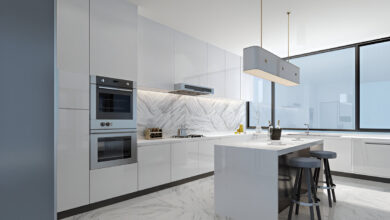Architects and Their Top 3D Modeling Software Choices
3D Modeling Software Choices

Article:
Architects: What Software Do You Use for 3D Modeling?
In the realm of architecture, the ability to visualize concepts and turn them into reality has been greatly enhanced by the advent of 3D modeling software. This technology has revolutionized how architects design, plan, and execute projects, allowing for a more immersive and precise representation of ideas. Let’s delve into the most popular 3D modeling software used by architects and understand how each tool caters to their specific needs.Technology: A Journey into the Future
Table of Contents
ToggleThe Rise of 3D Modeling in Architecture
The architectural landscape has drastically changed with the integration of 3D modeling software. These tools enable architects to create detailed and accurate representations of their designs, facilitating a better understanding of spatial relationships, materials, and overall aesthetics. This technological advancement has not only improved the design process but has also enhanced communication between architects, clients, and construction teams.
Top 3D Modeling Software Used by Architects
- Autodesk Revit
- Overview: Revit is a building information modeling (BIM) software that enables architects to design, visualize, and document building projects. It supports multi-discipline design processes and allows for detailed coordination across various engineering disciplines.
- Features: Revit offers features such as parametric modeling, where changes in one part of the design automatically update the entire model, ensuring consistency and accuracy. It also includes tools for rendering, construction documentation, and cloud-based collaboration.
- Why Architects Use It: Revit is popular among architects for its comprehensive BIM capabilities. It allows for a seamless transition from conceptual design to detailed documentation, facilitating better project coordination and reducing errors.
- SketchUp
- Overview: SketchUp is known for its user-friendly interface and is widely used for creating quick and accurate 3D models. It is ideal for architects who need to visualize concepts rapidly and present them effectively to clients.
- Features: With features like 3D Warehouse, SketchUp allows architects to access a vast library of pre-designed components, enhancing the efficiency of the modeling process. It also offers plugins for enhanced functionality and supports integration with other design software.
- Why Architects Use It: Architects appreciate SketchUp for its ease of use and versatility. It is an excellent tool for creating initial design concepts and exploring different design options quickly.
- AutoCAD
- Overview: AutoCAD is a versatile CAD software that is widely used in various industries, including architecture. It provides tools for 2D and 3D design, drafting, and documentation.
- Features: AutoCAD offers features such as dynamic blocks, parametric constraints, and a comprehensive set of drawing and editing tools. It also supports collaboration through cloud-based storage and sharing.
- Why Architects Use It: AutoCAD is a staple in the architectural industry due to its robust drafting capabilities. It is particularly useful for creating detailed plans and elevations and serves as a reliable platform for collaboration with other design professionals.Understanding Authorship Practices: Evaluating Common Statements
- Rhino 3D
- Overview: Rhino 3D is a powerful 3D modeling software that is widely used in architecture for creating complex forms and structures. It excels in handling freeform surfaces and organic shapes.
- Features: Rhino 3D provides features such as NURBS modeling, which allows for precise control over complex geometries. It also offers a wide range of plugins for rendering, analysis, and fabrication.
- Why Architects Use It: Architects choose Rhino 3D for its flexibility and precision in modeling intricate designs. It is particularly favored for projects that require unique and unconventional forms.
- ArchiCAD
- Overview: ArchiCAD is another BIM software that is specifically designed for architects. It offers a comprehensive set of tools for designing, documenting, and visualizing building projects.
- Features: ArchiCAD includes features such as integrated rendering, interactive 3D modeling, and team collaboration. It also supports open BIM standards, allowing for interoperability with other design software.
- Why Architects Use It: ArchiCAD is preferred by architects for its intuitive interface and robust BIM capabilities. It streamlines the design process and enhances productivity by enabling architects to focus on design rather than technical details.
Benefits of Using 3D Modeling Software
The use of 3D modeling software in architecture offers numerous benefits, including:
- Enhanced Visualization: Architects can create realistic and detailed models, allowing clients to visualize the final product before construction begins.
- Improved Collaboration: 3D models facilitate better communication and coordination among project stakeholders, reducing misunderstandings and errors.
- Increased Efficiency: These tools streamline the design process by automating repetitive tasks and providing instant feedback on design changes.
- Cost Savings: By identifying potential issues early in the design phase, architects can avoid costly modifications during construction.
Challenges and Considerations
While 3D modeling software offers many advantages, architects must also consider potential challenges:
- Learning Curve: Some software may have a steep learning curve, requiring significant time and effort to master.
- Cost: The cost of licensing and maintaining software can be substantial, especially for smaller firms.
- Hardware Requirements: High-performance hardware is often necessary to run these programs smoothly, adding to the overall investment.
Final Thoughts
The choice of 3D modeling software depends on the specific needs and preferences of the architect. Factors such as project complexity, budget, and collaboration requirements all play a role in determining the best tool for the job. As technology continues to evolve, architects must stay informed about the latest software developments to remain competitive in the industry.
Questions and Answers
Q: Can 3D modeling software be used for all types of architectural projects? A: Yes, 3D modeling software is versatile and can be used for various types of architectural projects, from residential buildings to large commercial complexes.
Q: How do architects choose the right software for their projects? A: Architects consider factors such as project requirements, budget, ease of use, and integration with other tools when choosing the right software.
Q: Is it necessary to learn multiple 3D modeling software? A: While it is beneficial to have knowledge of multiple software, architects often specialize in one or two tools that best suit their design style and workflow
Category: Architecture and Design
By integrating these tools into their workflows, architects can bring their visions to life with greater accuracy and efficiency. Whether you are an experienced professional or just starting, understanding the capabilities of different 3D modeling software is crucial for success in the field.
https://lightbeans.com/en/blog/tutorials/best-3-d-design-software-for-architects-and-designers
4o





